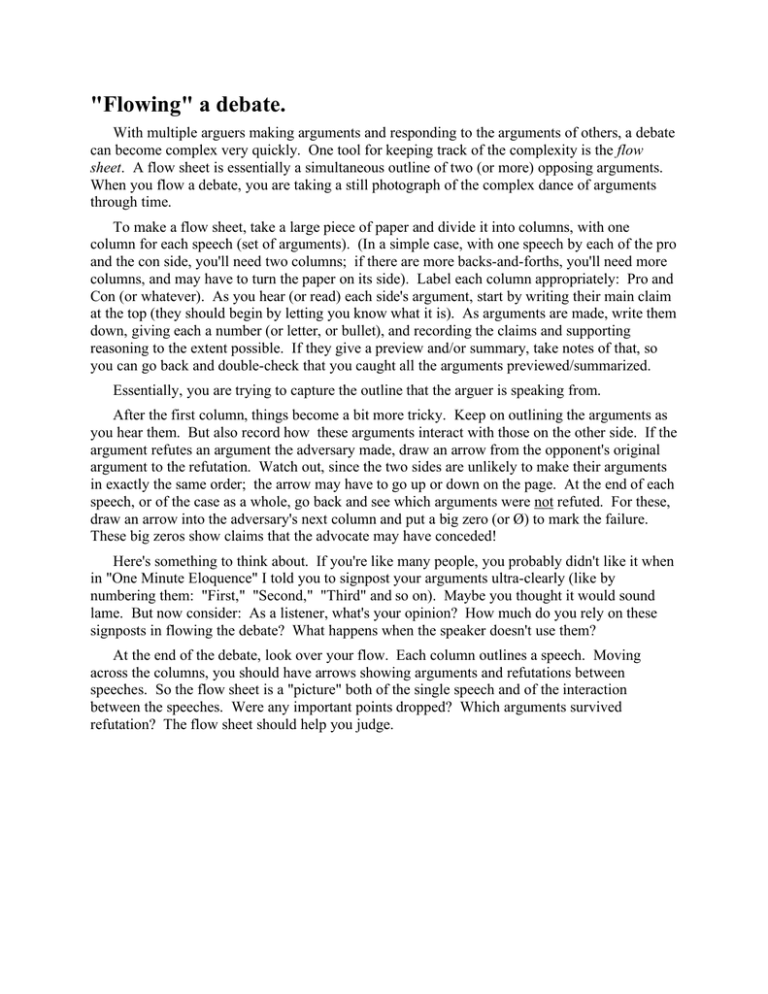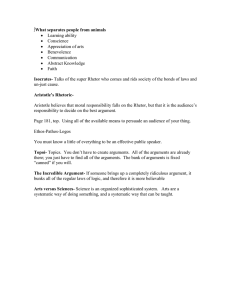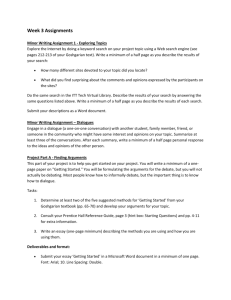"Flowing" a debate.
advertisement

"Flowing" a debate. With multiple arguers making arguments and responding to the arguments of others, a debate can become complex very quickly. One tool for keeping track of the complexity is the flow sheet. A flow sheet is essentially a simultaneous outline of two (or more) opposing arguments. When you flow a debate, you are taking a still photograph of the complex dance of arguments through time. To make a flow sheet, take a large piece of paper and divide it into columns, with one column for each speech (set of arguments). (In a simple case, with one speech by each of the pro and the con side, you'll need two columns; if there are more backs-and-forths, you'll need more columns, and may have to turn the paper on its side). Label each column appropriately: Pro and Con (or whatever). As you hear (or read) each side's argument, start by writing their main claim at the top (they should begin by letting you know what it is). As arguments are made, write them down, giving each a number (or letter, or bullet), and recording the claims and supporting reasoning to the extent possible. If they give a preview and/or summary, take notes of that, so you can go back and double-check that you caught all the arguments previewed/summarized. Essentially, you are trying to capture the outline that the arguer is speaking from. After the first column, things become a bit more tricky. Keep on outlining the arguments as you hear them. But also record how these arguments interact with those on the other side. If the argument refutes an argument the adversary made, draw an arrow from the opponent's original argument to the refutation. Watch out, since the two sides are unlikely to make their arguments in exactly the same order; the arrow may have to go up or down on the page. At the end of each speech, or of the case as a whole, go back and see which arguments were not refuted. For these, draw an arrow into the adversary's next column and put a big zero (or Ø) to mark the failure. These big zeros show claims that the advocate may have conceded! Here's something to think about. If you're like many people, you probably didn't like it when in "One Minute Eloquence" I told you to signpost your arguments ultra-clearly (like by numbering them: "First," "Second," "Third" and so on). Maybe you thought it would sound lame. But now consider: As a listener, what's your opinion? How much do you rely on these signposts in flowing the debate? What happens when the speaker doesn't use them? At the end of the debate, look over your flow. Each column outlines a speech. Moving across the columns, you should have arrows showing arguments and refutations between speeches. So the flow sheet is a "picture" both of the single speech and of the interaction between the speeches. Were any important points dropped? Which arguments survived refutation? The flow sheet should help you judge.






